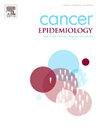肺癌患者侵袭性肺真菌病流行病学及危险因素分析
IF 2.3
3区 医学
Q3 ONCOLOGY
引用次数: 0
摘要
背景:由于恶性肿瘤相关的免疫抑制,肺癌患者对侵袭性肺真菌病(IPFD)的易感性增加。目前关于该人群中IPFD病原体分布概况的数据仍然有限。本研究旨在了解肺癌患者中引起IPFD的真菌病原体的流行病学分布,以指导临床管理。方法回顾性分析2019年6月至2024年5月在山西医科大学第二医院连续治疗的肺癌患者。如果患者有IPFD出院诊断,接受抗真菌治疗,或有真菌感染的微生物证据,则纳入患者。所有患者均根据2007年肺部真菌感染修订共识进行诊断。收集了人口统计学、临床和实验室数据。采用单因素和多因素logistic回归分析确定IPFD的独立危险因素。结果1274例肺癌患者中,92例确诊或可能患有IPFD。念珠菌(57.4% %)和曲霉菌(35.3% %)为优势致病菌,标本来源为痰液(77.94 %)、支气管肺泡灌洗液(17.65 %)和组织(4.41 %)。多因素分析确定IPFD合并肺癌的独立危险因素如下:高血压(OR=5.08;95 %CI: 1.41-18.28, P = 0.013),慢性呼吸系统疾病(OR=3.13;95 %CI: 1.14-8.56, P = 0.026),骨髓抑制(OR=2.72;95 % CI: 1.17-6.33, P = 0.020),多种合并症(OR=2.68;95 % CI: 1.02 - -7.09, P = 0.046),和吸烟(OR = 2.47;95 % ci: 1.08-5.64, p = 0.032)。结论尘螨和曲霉菌是肺癌患者IPFD最常见的病原体。然而,本研究中观察到的不太常见的真菌如头地霉和小孢子根霉的出现频率越来越高,需要提高临床警惕。认识到慢性呼吸系统疾病、男性、高血压、多种合并症和吸烟等关键危险因素,可以指导早期诊断和有针对性的抗真菌治疗,最终改善临床结果。本文章由计算机程序翻译,如有差异,请以英文原文为准。
Epidemiology and risk factors of invasive pulmonary fungal disease in patients with lung cancer
Background
Patients with lung cancer exhibit heightened susceptibility to invasive pulmonary fungal diseases (IPFD) due to malignancy-associated immunosuppression. Current data on the pathogen distribution profile of IPFD in this population remain limited. This study investigated the epidemiological distribution of fungal pathogens causing IPFD in patients with lung cancer, with the aim of guiding clinical management.
Methods
We conducted a retrospective analysis of consecutive patients with lung cancer treated at the Second Hospital of Shanxi Medical University from June 2019 to May 2024. Patients were included if they had a discharge diagnosis of IPFD, received antifungal therapy, or presented microbiological evidence of fungal infection. All patients were diagnosed according to the 2007 Revised Consensus on Pulmonary Fungal Infections. Demographic, clinical, and laboratory data were collected. Univariate and multivariate logistic regression analyses were employed to identify independent IPFD risk factors.
Results
Of 1274 with lung cancer, 92 had proven or probable IPFD. Candida spp. (57.4 %) and Aspergillus spp. (35.3 %) were the predominant pathogens, with sputum (77.94 %), bronchoalveolar lavage fluid (17.65 %), and tissue (4.41 %) as specimen sources. Multivariate analysis identified the following independent risk factors for IPFD with lung cancer: hypertension (OR=5.08; 95 %CI: 1.41–18.28, P = 0.013), chronic respiratory diseases (OR=3.13; 95 %CI: 1.14–8.56, P = 0.026), bone marrow suppression (OR=2.72; 95 % CI: 1.17–6.33, P = 0.020), multiple comorbidities (OR=2.68; 95 % CI: 1.02–7.09, P = 0.046), and smoking (OR=2.47; 95 %CI: 1.08–5.64, P = 0.032).
Conclusions
Candida and Aspergillus species were the most common causative agents of IPFD in patients with lung cancer. However, the emergence of less common fungi such as Geotrichum capitatum and Rhizopus microsporus, observed with increasing frequency in this study, warrants heightented clinical vigilance. Recognizing key risk factors, including chronic respiratory diseases, male sex, hypertension, multiple comorbidities and smoking, may guide early diagnosis and targeted antifungal therapy, ultimately improving clinical outcomes.
求助全文
通过发布文献求助,成功后即可免费获取论文全文。
去求助
来源期刊

Cancer Epidemiology
医学-肿瘤学
CiteScore
4.50
自引率
3.80%
发文量
200
审稿时长
39 days
期刊介绍:
Cancer Epidemiology is dedicated to increasing understanding about cancer causes, prevention and control. The scope of the journal embraces all aspects of cancer epidemiology including:
• Descriptive epidemiology
• Studies of risk factors for disease initiation, development and prognosis
• Screening and early detection
• Prevention and control
• Methodological issues
The journal publishes original research articles (full length and short reports), systematic reviews and meta-analyses, editorials, commentaries and letters to the editor commenting on previously published research.
 求助内容:
求助内容: 应助结果提醒方式:
应助结果提醒方式:


